NEW YORK—Traffic is adjusting flow and pedestrians are spilling onto the newly-created open spaces along Broadway. Memorial weekend signaled a change to Times Square that may reconfigure the heart of Manhattan forever.
The face of retail has changed for many businesses with the Green Light for Midtown project undertaken by the NYC Department of Transportation (DOT). Experts are saying retail turnover could increase up to 20 percent along the new pedestrian corridors.
“Times Square is the heaviest pedestrian place in America,” said Paul Fetscher, president of Great American Brokerage. More than 350,000 people walk through Times Square each day on overflowing sidewalks, the DOT figures say.
More space for people to slow down, stop, gather, and rest will change shopping patterns. “It should result in more [retail] transactions,” Fetscher said. “People can’t make a purchase when they’re in their vehicle.”
There are 4.5 times as many people as vehicles in the area, and until now, only 11 percent of the space was allocated for pedestrians, the DOT report said. Traffic on Broadway moved on average 4.2 miles per hour and crash statistics were 137 percent higher than at the nearby Avenues. More than 3 acres of open space will be added to the Broadway strip by project completion in August.
“It’s going to be a great urban oasis,” said Fetscher.
The entire project runs along Broadway from Columbus Circle to 25th Street.
The Broadway office rental market currently lags behind other prime midtown corridors by 25 percent, stated a DOT report.
Fetscher said this is unlikely to change much. “It may increase a dollar or two per square foot.” He recently heard of a retail rental going for $750 per sq. ft.
“That exceeded rents in Fifth Avenue,” he said, but was unsure of the final signing price. Fifth Avenue is traditionally the highest rent area for retail in Manhattan, with the Gucci shop in the Trump building breaking price records when it opened its flagship store in 2008.
There are more hours of retail on Times Square than Fifth Avenue, Fetscher said, giving it a competitive edge. But, prices won’t go too high, he said, “If you have a slackening in demand and a softening in price, a tenant in place is worth more.”
Scott Bennett, a broker for Prime Manhattan Realty agreed. “I do not sense there will be any drastic changes [to office rentals],” he said. There will be a much bigger impact on retail and Times Square will become a much more desirable location, he said.
“It will help the retail increase by about 20 percent due to the increase in people traffic.”
The Walgreens at Times Square has been busier, said executive assistant manager, Julie Lopez. “It’s definitely been busier. Especially over the weekend. It was really, really packed in here.”
A hospitality worker on Times Square said the idea was excellent, but he was concerned about the lack of public toilets in the area.
Herald Square retailers have had a mixed start to the change. A sales rep at the Gap and another at Sunglass Hut said that customer traffic hadn’t changed much since Friday.
Sales at Fashion retailer Conway on Broadway and 35th St. have been low. Manager Eula Kistoo said that business was bad since Friday. “On holidays usually we get more traffic because there’s more parking,” she said. “But this Saturday was really bad.”
The store saw a $20,000 drop in business on Saturday and $15,000 on Sunday compared to other weekends. She said the new layout caused trouble for her getting to work. “My husband drove me in and we were like, ‘now what?’” Kistoo thinks the downward trend in business will continue.
President of the Times Square Alliance, Tim Tompkins, said things are a disrupted right now. “Our hopes are, on the one hand, that there is no negative impact,” he said. “Theaters are the main concern.”
There has been some opposition to the changes by the theater community he said, especially those driving in from the suburbs. Dropping off and parking has become restrictive with the blocking of roads.
“There may be adjustments to some of the parking regulations, if necessary,” Tompkins said. He said he expects to have a clearer picture of the impact in a month’s time.
“So far it’s been pretty smooth,” he said. “This is an important part of the evolution of how people look at public space. It’s not a car versus people issue, it’s more about making a destination appealing.”
DOT will monitor this pilot project throughout the summer and fall and submit a project evaluation report by the end of 2009.
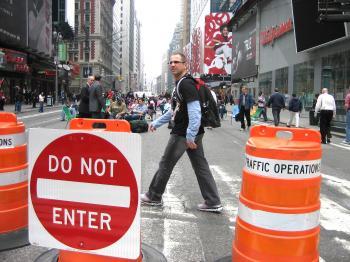

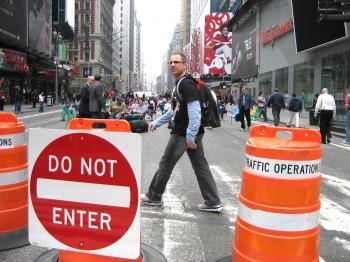
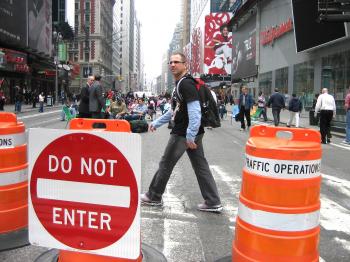
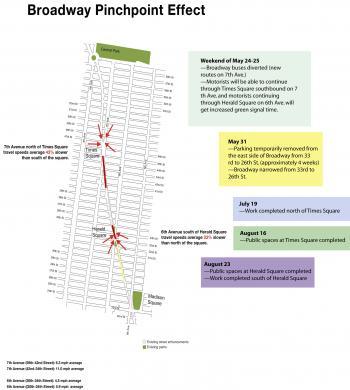
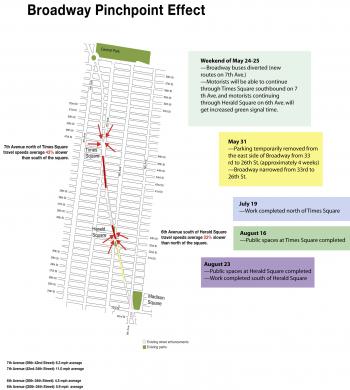




Friends Read Free